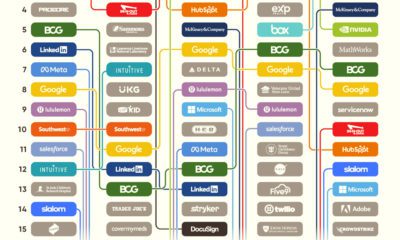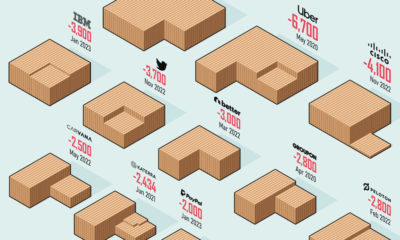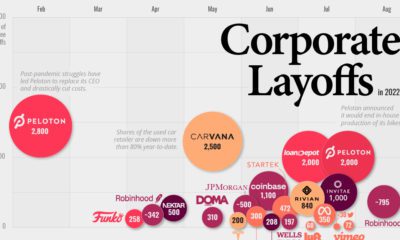And yet, in a short period of time, the emergence of the smartphone has enabled the gig economy to flourish into a multi-trillion dollar global market. And by leveraging apps like Uber, Airbnb, and Etsy, it’s estimated that 57 million people in the U.S. now participate in the gig economy each year in some shape or form. What apps do these people use to turn their time, skills, hobbies, or assets (cars, home, parking spaces, etc.) into additional income streams?
App Examples
Today’s infographic comes to us from TitleMax, and it lists 150 different apps that are used within the gig economy – including many that pay gig workers directly. Here are just some of the apps that are used in some of the major categories above: Ridesharing Uber and Lyft are what many think of when they hear about the gig economy. However, there are now dozens of rideshare apps out there to fill different niches – for example, Wingz offers flat-fee rides to the airport, while Curb connects riders with professional taxi drivers. Errands TaskRabbit, which was bought by IKEA, turns errands such as assembling furniture or cleaning a gutter into payable gigs. Meanwhile, apps like Dolly and Bellhops will connect you with movers, and LawnLove is for lawn care. Art, Design, and Crafting Etsy, a marketplace for handmade goods, is one the of the best known brands in this category. However, there are many other niche options here as well – for example, UncommonGoods specializes in unique gifts, while Society6 focuses on gallery quality art prints. Writing and Editing Lulu and Kindle Direct allow you to publish eBooks online and sell them, while proofreaders and editors can get paid for their copy editing services through Gramlee. Delivery Fast and efficient delivery services are a centerpiece to the gig economy, and there are no shortage of options here. DoorDash, UberEats, Caviar, and GrubHub allow users to get food delivered to their doors, while apps like Instacart focus on grocery delivery. Multimedia We all know that you can create videos and monetize them on places like YouTube or Twitch, but did you know you can be a voice actor through services like VoiceBunny? You can also sell rights to your photos via Foap, or do freelancing work through Upwork or Fiverr. Whether you are tapping into the gig economy for an extra income stream or you are incorporating gig economy services into your life for added convenience, there is no shortage of options to choose from. on But fast forward to the end of last week, and SVB was shuttered by regulators after a panic-induced bank run. So, how exactly did this happen? We dig in below.
Road to a Bank Run
SVB and its customers generally thrived during the low interest rate era, but as rates rose, SVB found itself more exposed to risk than a typical bank. Even so, at the end of 2022, the bank’s balance sheet showed no cause for alarm.
As well, the bank was viewed positively in a number of places. Most Wall Street analyst ratings were overwhelmingly positive on the bank’s stock, and Forbes had just added the bank to its Financial All-Stars list. Outward signs of trouble emerged on Wednesday, March 8th, when SVB surprised investors with news that the bank needed to raise more than $2 billion to shore up its balance sheet. The reaction from prominent venture capitalists was not positive, with Coatue Management, Union Square Ventures, and Peter Thiel’s Founders Fund moving to limit exposure to the 40-year-old bank. The influence of these firms is believed to have added fuel to the fire, and a bank run ensued. Also influencing decision making was the fact that SVB had the highest percentage of uninsured domestic deposits of all big banks. These totaled nearly $152 billion, or about 97% of all deposits. By the end of the day, customers had tried to withdraw $42 billion in deposits.
What Triggered the SVB Collapse?
While the collapse of SVB took place over the course of 44 hours, its roots trace back to the early pandemic years. In 2021, U.S. venture capital-backed companies raised a record $330 billion—double the amount seen in 2020. At the time, interest rates were at rock-bottom levels to help buoy the economy. Matt Levine sums up the situation well: “When interest rates are low everywhere, a dollar in 20 years is about as good as a dollar today, so a startup whose business model is “we will lose money for a decade building artificial intelligence, and then rake in lots of money in the far future” sounds pretty good. When interest rates are higher, a dollar today is better than a dollar tomorrow, so investors want cash flows. When interest rates were low for a long time, and suddenly become high, all the money that was rushing to your customers is suddenly cut off.” Source: Pitchbook Why is this important? During this time, SVB received billions of dollars from these venture-backed clients. In one year alone, their deposits increased 100%. They took these funds and invested them in longer-term bonds. As a result, this created a dangerous trap as the company expected rates would remain low. During this time, SVB invested in bonds at the top of the market. As interest rates rose higher and bond prices declined, SVB started taking major losses on their long-term bond holdings.
Losses Fueling a Liquidity Crunch
When SVB reported its fourth quarter results in early 2023, Moody’s Investor Service, a credit rating agency took notice. In early March, it said that SVB was at high risk for a downgrade due to its significant unrealized losses. In response, SVB looked to sell $2 billion of its investments at a loss to help boost liquidity for its struggling balance sheet. Soon, more hedge funds and venture investors realized SVB could be on thin ice. Depositors withdrew funds in droves, spurring a liquidity squeeze and prompting California regulators and the FDIC to step in and shut down the bank.
What Happens Now?
While much of SVB’s activity was focused on the tech sector, the bank’s shocking collapse has rattled a financial sector that is already on edge.
The four biggest U.S. banks lost a combined $52 billion the day before the SVB collapse. On Friday, other banking stocks saw double-digit drops, including Signature Bank (-23%), First Republic (-15%), and Silvergate Capital (-11%).
Source: Morningstar Direct. *Represents March 9 data, trading halted on March 10.
When the dust settles, it’s hard to predict the ripple effects that will emerge from this dramatic event. For investors, the Secretary of the Treasury Janet Yellen announced confidence in the banking system remaining resilient, noting that regulators have the proper tools in response to the issue.
But others have seen trouble brewing as far back as 2020 (or earlier) when commercial banking assets were skyrocketing and banks were buying bonds when rates were low.













